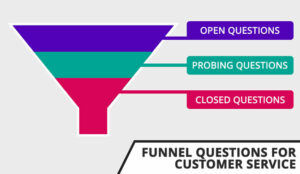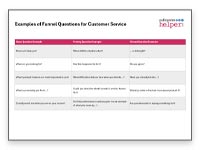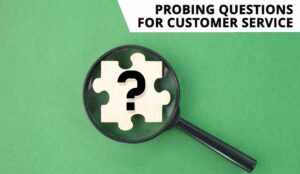Asking the right questions is the key to effective communication, whether in customer service, coaching, or problem-solving.
But not all questions are created equal, some open up a discussion, while others drill down to the heart of the matter.
This is where funnel questions come in.
By structuring questions in a way that moves from broad to specific, funnel questioning helps uncover deeper insights, clarify concerns, and guide conversations in a logical flow.
Whether you’re troubleshooting an issue, coaching an employee, or gathering customer feedback, mastering this technique can lead to more productive and meaningful discussions.
In this article we take a look at funnel questions, explain the funnel effect, and provide examples and advice for using this technique.
What Are Funnel Questions?
Funnel questions are a structured questioning technique that starts with broad, open-ended inquiries and gradually narrows to more specific details.
This method helps guide conversations logically, ensuring key information is uncovered step by step.
For example, a customer service agent might begin with “Can you describe the issue?” before asking “When did it start?” and “Have you tried any solutions?”
By refining the discussion in stages, funnel questions improve clarity, prevent miscommunication, and lead to better problem-solving—an approach known as the funnel effect.
The Funnel Effect
“The Funnel Effect” involves creating a questioning funnel by asking open, probing and closed questions – in that order.
The diagram below highlights this.
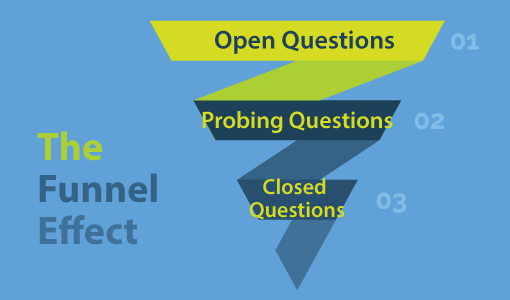
Step 1 – Ask Open Questions
Open questions require detailed answers. They cannot be answered with a “yes” or “no”. Asking these questions helps to gather information from the get-go. Sometimes, the open question “How may I help you?” is all an advisor needs to ask before probing.
Step 2 – Ask Probing Questions
Probing questions allow advisors to home in on crucial bits of information gathered after asking open questions. They also help uncover grey areas within a customer’s account of events, understand the impact and clarify preferred outcomes.
Step 3 – Ask Closed Questions
Closed questions help take control of a conversation once the advisor has all the information they need. Restricting customer responses to “yes” or “no”, these questions are also great for confirming details within the answers to open and probing questions.
After finishing on a closed question, advisors can press ahead and focus on finding a solution.
Within many contact centres, going through this process is known as putting a query “through the funnel”.
Examples of Funnel Questions
To further highlight the difference between each type of question, here are some examples of funnel questions.
- “How can I help you?” – Open Question
- “When did the situation start?” – Probing Question
- “… is that right?” – Closed Question
- “What are you looking for?” – Open Question
- “Has this happened before?” – Probing Question
- “Do you agree?” – Closed Question
- “Which product features are most important to you?” – Open Question
- “What difficulties did you face when you tried to…?” – Probing Question
- “Have you already tried to…?” – Closed Question
- “What is preventing you from…?” – Open Question
- “Could you describe what it sounds / looks like?” – Probing Question
- “Would you like to find out more about product X?” – Closed Question
- “Could you tell me what you see on your screen?” – Open Question
- “So I fully understand, could you give me an example of what you mean by…?” – Probing Question
- “Are you interested in buying something too?” – Closed Question
Using these questions within the filter helps to deal with challenging calls. During simpler transactional calls, advisors may take the lead. To do so, they can ask more closed questions and apply techniques like signposting to provide a more effortless customer service experience.
However, in a world where self-service and automation is eating up all of these easier calls, advisors must become more skilful at questioning. The Funnel Effect is, therefore, an excellent string to the modern advisor’s bow.
Printable – Examples of Funnel Questions for Customer Service
Do you want to download this to share with your team?
Get your free download of Examples of Funnel Questions for Customer Service now:
Funnel Question Examples in Customer Conversations
Below are three real-world examples of how the Funnel Effect is used in contact centre interactions to troubleshoot issues and resolve queries smoothly.
Example 1: The Faulty Return
When customers report a faulty product, they often jump straight to asking about returns. However, gathering key details first can streamline the process and prevent unnecessary follow-ups.
In this scenario, the advisor begins with a general question, then uses empathy and targeted follow-ups to gather critical information, while also addressing a potential future concern about data removal.
- Advisor: How can I help you today?
- Customer: I bought something that doesn’t work. I’ve tried everything. How can I return it?
- Advisor: That’s not good. I’m sorry to hear you’ve tried everything and it’s not working. I can help you return it. First, could I ask, what type of product is it?
- Customer: It’s a laptop. It keeps freezing.
- Advisor: Yes, I can imagine that’s frustrating. How often is it freezing?
- Customer: Every half an hour or so.
- Advisor: That’s okay. The reason I ask is to see if you have long enough to disable any security features and remove your personal data before you send it back, which you do. Could you do that yourself or would you like my help?
- Customer: I can do that myself, thanks.
- Advisor: Excellent. So, to return the faulty laptop you must [CONVERSATION CONTINUES]
After beginning the call with an open question, the advisor uses two probing questions. However, they bridge between the questions by using empathy statements such as:
- “That’s not good. I’m sorry to hear you’ve tried everything, and it’s not working…”
- “I can imagine that’s frustrating…”
Doing so helps to build rapport with customers, and it also helps to avoid overwhelming customers with question after question.
Interestingly, the closed question also attempts to pre-empt a future contact. If the customer begins the returns process before realizing that they must wipe data from their laptop, they may call again. Asking the simple question could prove valuable in simplifying service.
Example 2: The Faulty Fix
When appliances stop working properly, customers may not know what’s causing the issue. In this example, the advisor starts broad and then narrows down the possible reasons.
They use positive reinforcement and expert guidance to keep the conversation constructive and engaging, ensuring the customer feels confident in the next steps.
- Advisor: How may I help you?
- Customer: My washing machine isn’t cleaning properly.
- Advisor: I’m sorry that you’ve had to deal with that. Let’s see what we can do. Could I first ask: how high are you filling up the washing machine?
- Customer: About halfway.
- Advisor: That’s excellent. Many people overfill their washing machines, causing this issue. It’s great that you’re not doing that. What I recommend is that you run a maintenance wash. Have you done that already?
- Customer: No.
- Advisor: Good. That is our best bet, then. Do you still have the manual or would you like me to talk you through it?
- Customer: Yes, I have the manual, thanks.
- Advisor: Fabulous. It’s a straightforward process. The key things to remember are… [CONVERSATION CONTINUES]
From the customer’s first response, the advisor can narrow down the cause of the issue to one of two options:
- The customer is overfilling their washing machine
- The washing machine needs a rest.
The advisor then probes to discover which is at play. Upon learning that the issue is not due to a customer mistake, the advisor begins using positive words to build rapport.
“Excellent”, “great”, “good”, “best”, and “fabulous” are used, helping to generate enthusiasm around the solution of a maintenance wash.
Finally, the advisor twice demonstrates their expertise while bridging their questions. They tell the customer:
- Many people overfill their washing machines, causing this issue.
- It’s a straightforward process. The key things to remember are…
Doing so reassures the customer, so they feel as though they are in good hands.
Example 3: The Moving Customer
Policy changes during a move can be confusing, and customers may not know what adjustments are needed.
In this scenario by asking a probing question about the customer’s new location, the advisor gathers the necessary details before offering a clear solution.
Additionally, they pre-empt a likely follow-up query and proactively guide the customer toward a self-service option, reducing future contact centre strain.
- Advisor: What can I do to help you today?
- Customer: I’m moving house. What is going to happen to my policy when I move?
- Advisor: Congratulations. That’s exciting! Just so I can answer your question, where are you moving?
- Customer: Just up the road. Still in Coventry.
- Advisor: Excellent. As you’re still in the country, everything will stay the same. You will need to update the address on your policy, though, once you’ve moved. Would you like me to send you a link to do that online?
- Customer: Yes, that’s helpful. Thanks.
To answer the query, the advisor must find out more. They do so with a probing question, which helps to uncover where the customer is moving.
It is then simple enough for the advisor to provide a sufficient answer. Yet they again pre-empt a future query with a final closed question. That query would have been: “How do I change the address on my policy?”
Not only that, but they also influence the future channel choice of the customer, relieving future strain on the contact centre.
Predicting future customer behaviours like this and coaching advisors to influence them is a progressive contact centre strategy that can increase efficiency.
How to Ask Good Probing Questions
“Probing is the art of delving deeper into what caused the issue. Asking probing questions ensures that you find the underlying cause of the issue,” says Rea Alducente, a popular industry vlogger otherwise known as Rea Ninja.
After finding the root cause of an issue, advisors may work towards an appropriate solution. But it is not always as easy as in the examples above. Sometimes customers are not sure of themselves. Other times advisors will have never before come across the issue.
Advisors must, therefore, work on their probing skills, which include active listening, self-awareness and patience. Keeping an open mind is critical, as assumptions are often the enemy.
Skilled in each of these areas, advisors will naturally ask great probing questions. Until they reach that point, however, asking TED questions are often a good hack.
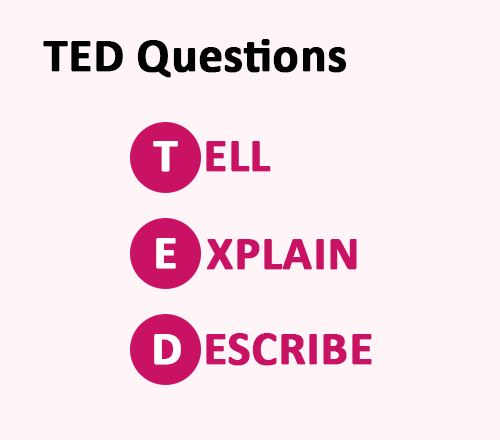
TED stands for:
- Tell me – e.g. Tell me, what happened when you…?
- Explain to me – e.g. Explain to me how it looks?
- Describe – e.g. Describe what you were doing when you first noticed the issue?
By adding these prefixes to their questions, advisors will automatically probe customers, encouraging them to share specifics.
Just try to mix it up. Avoid always saying “Tell me…” and remember to use common courtesies – such as “please” and “thank you” – to maintain a friendly tone.
Interested in learning more probing questions to add value to your contact centre conversations? Here is an excellent list of examples: 17 Probing Questions to Improve Your Customer Service
Accompany Questions With the Right Attitude
To ask great questions, advisors must want to like and help the customer. Asking advisors to be wary of the “Halo and Horn Effect” encourages this positive mindset.
The Halo Effect
When the customer brings out the best in an advisor, they begin to build a good rapport. The advisor then takes on a figurative halo.
The Horn Effect
When the customer has their back up against the wall, making them feel defensive, advisors often feel an urge to provide worse service. Unwilling to support the customer, they assume a figurative horn.
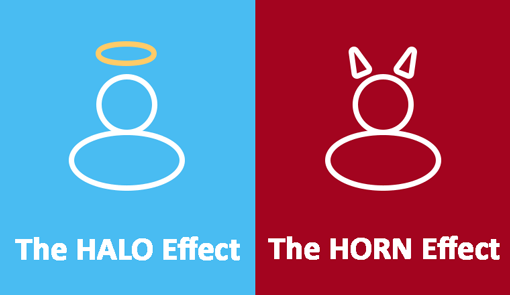
Yet it’s not only when dealing with angry customers that advisors experience “The Horn Effect”. As Carolyn Blunt, a customer service specialist, once told us: “If you have customers who ring time and time again, draining your energy, your eyes start to roll… Here we go again.”
Such a negative mindset sticks with advisors as they move from one call to another. Even with pleasant customers, the advisor feels bitter from the previous call, infecting their call handling skills.
However, if they remain aware of the Horn vs. Halo Effect, advisors can better recognize their emotions and ensure they do not impact their customer service approach.
A confident advisor – who avoids the dangers of the Horn Effect – is likely to deliver superb customer service. With great people, processes and technologies surrounding them, advisors can create exceptional service experiences.
After all, mindsets are vital. Advisors must be willing to ask the best questions to ensure that the Funnel Effect elicits the right results.
Discover more questioning techniques to bolster customer service in our articles:
- 10 Effective Questioning Techniques for Customer Service
- The Art of Conversation in Customer Service
- Call Control Techniques: Controlling a Runaway Talker on the Telephone
Author: Charlie Mitchell
Reviewed by: Robyn Coppell
Published On: 30th Mar 2022 - Last modified: 6th Jan 2026
Read more about - Skills, Carolyn Blunt, Charlie Mitchell, Customer Service, Editor's Picks, Free Downloads, Questioning Techniques, Rea Alducente, Skill Development





